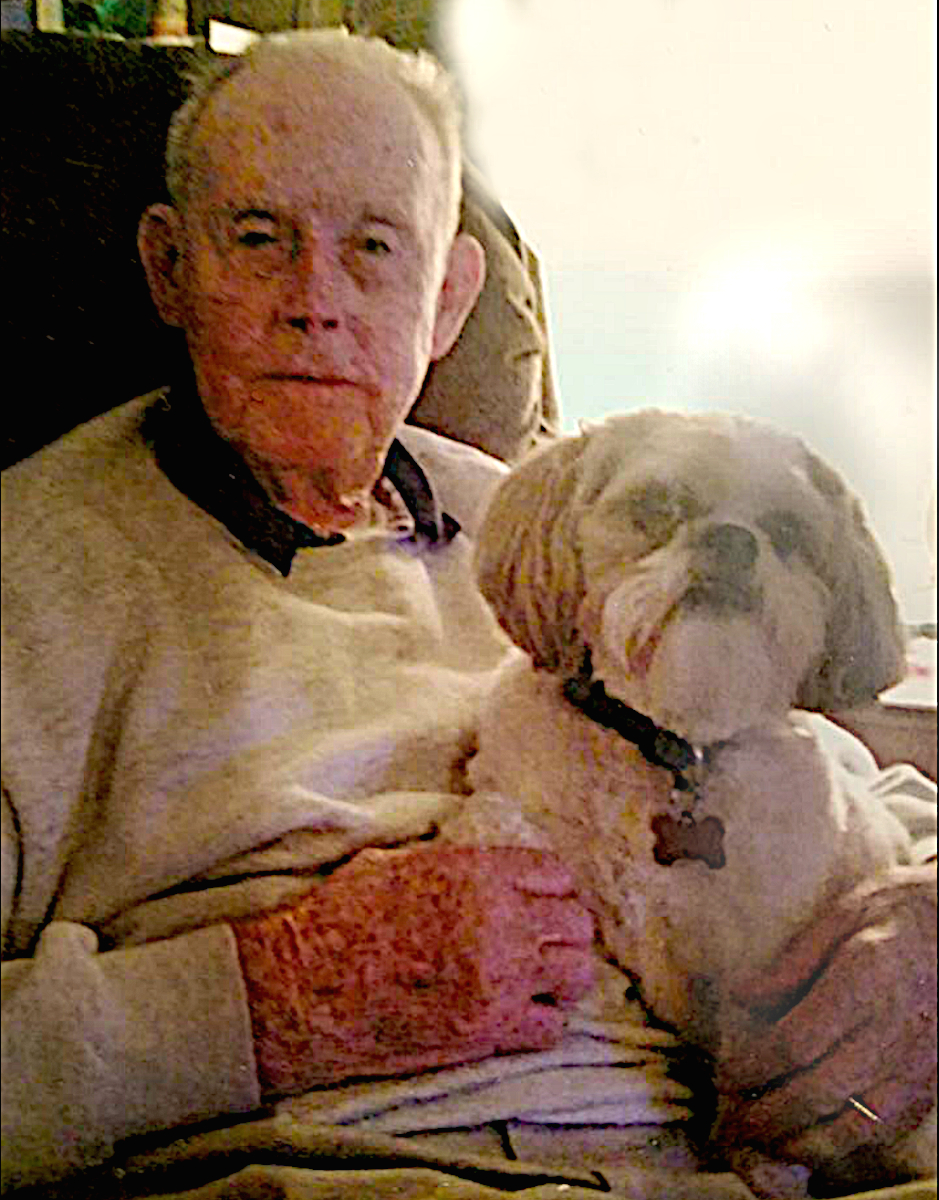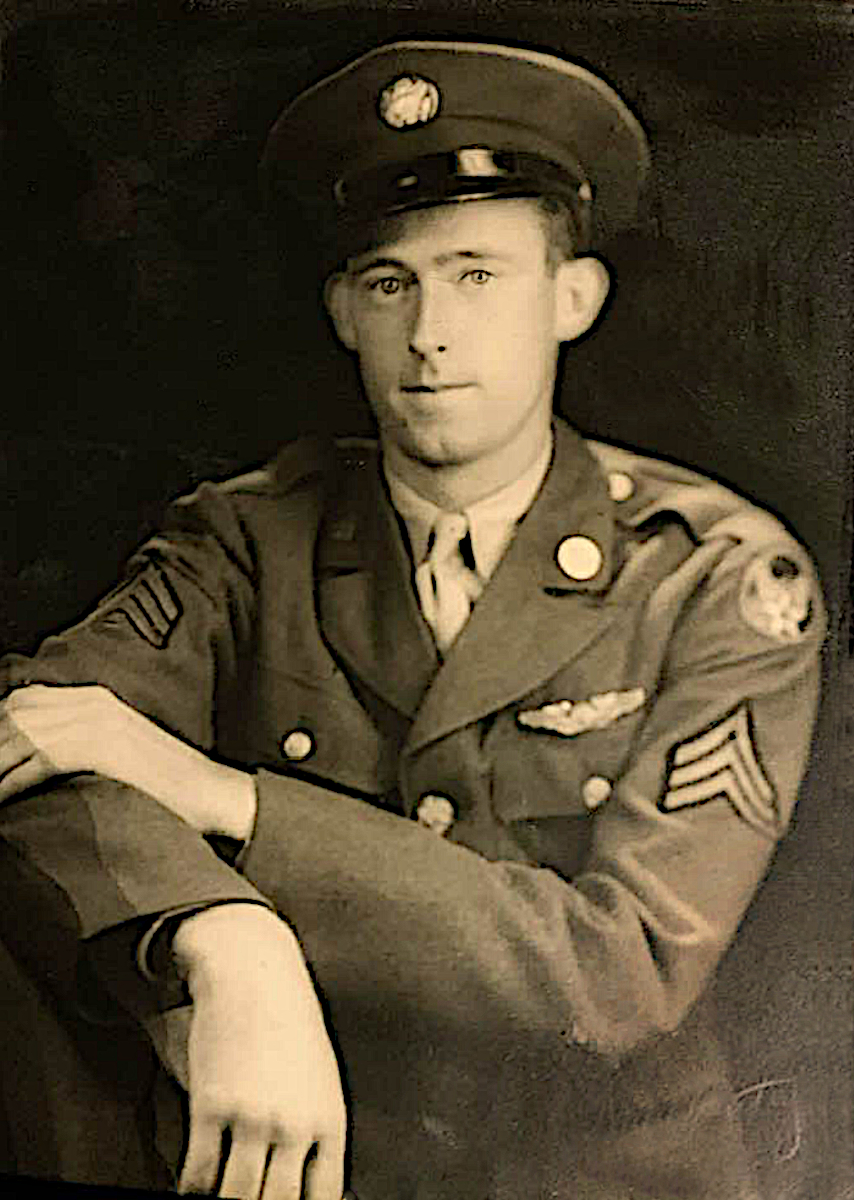S/Sgt. Carl Teahan
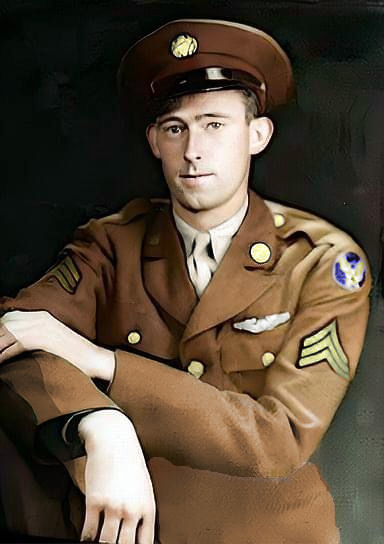
Carl Teahan was a Tail-Gunner in B-26 Marauders as part of the 494th Bomb Squadron, 344th Bomb Group. He flew 59 combat missions over enemy-occupied Europe and was the recipient of the Distinguished Flying Cross, Air Medal with 9 oak leaf clusters, two Bronze Battle Stars, European Theater Medal, Overseas Service Bar and the Good Conduct Medal.
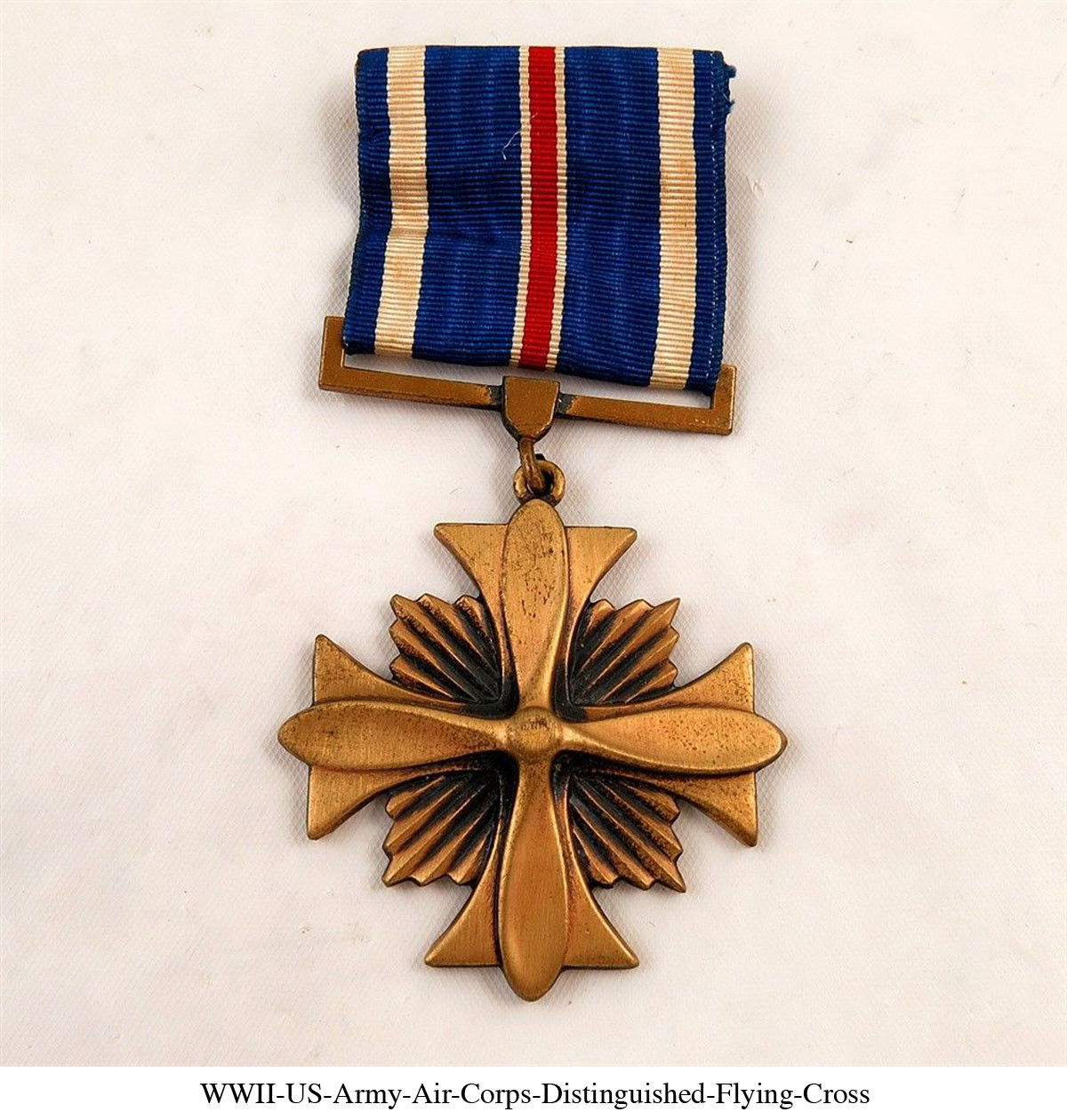
Some of S/Sgt. Teahan’s missions with the 344th Bomb Group
On April 8, 1944 the target was Coxyde Airdrome in Belgium near the coast and Dunkirk.
According to 344th Silver Streaks– “
On April 8, 1944, thirty-nine planes flew out to attack a marshalling yard but the weather continued to preclude accurate bombing. The group never reached its primary or secondary objectives and turned about to return. On the way to base, the first Box unloosed its bombs on Coxyde Airdrome on the Belgium coast just north of Dunkirk, hitting in the south dispersal area. Several buildings and a hangar received direct hits as well as revetments and a refueling loop. The second Box failed to bomb and brought its bombs
home. Flak encountered that date damaged thirteen ships slightly. No casualties resulted to personnel.”
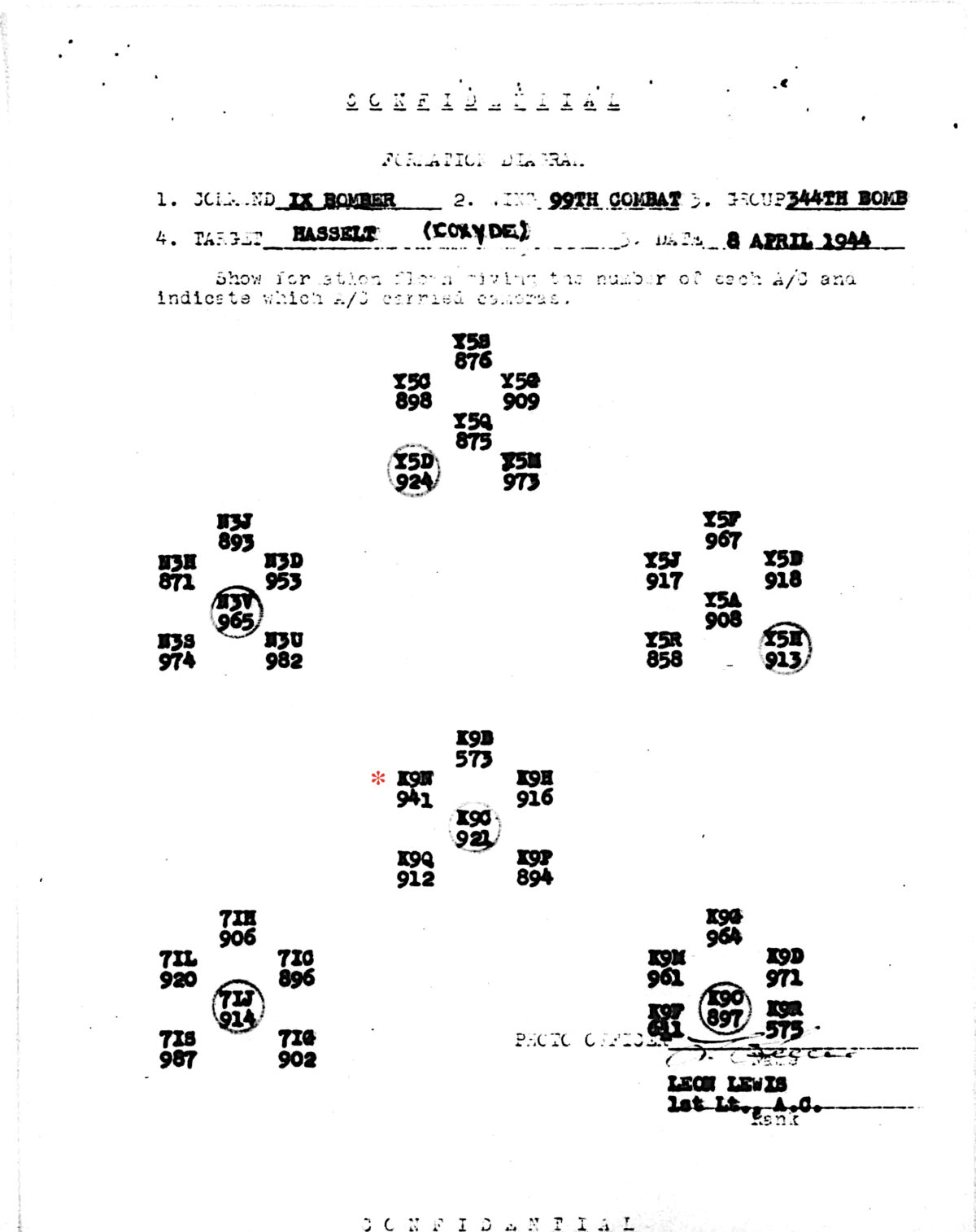
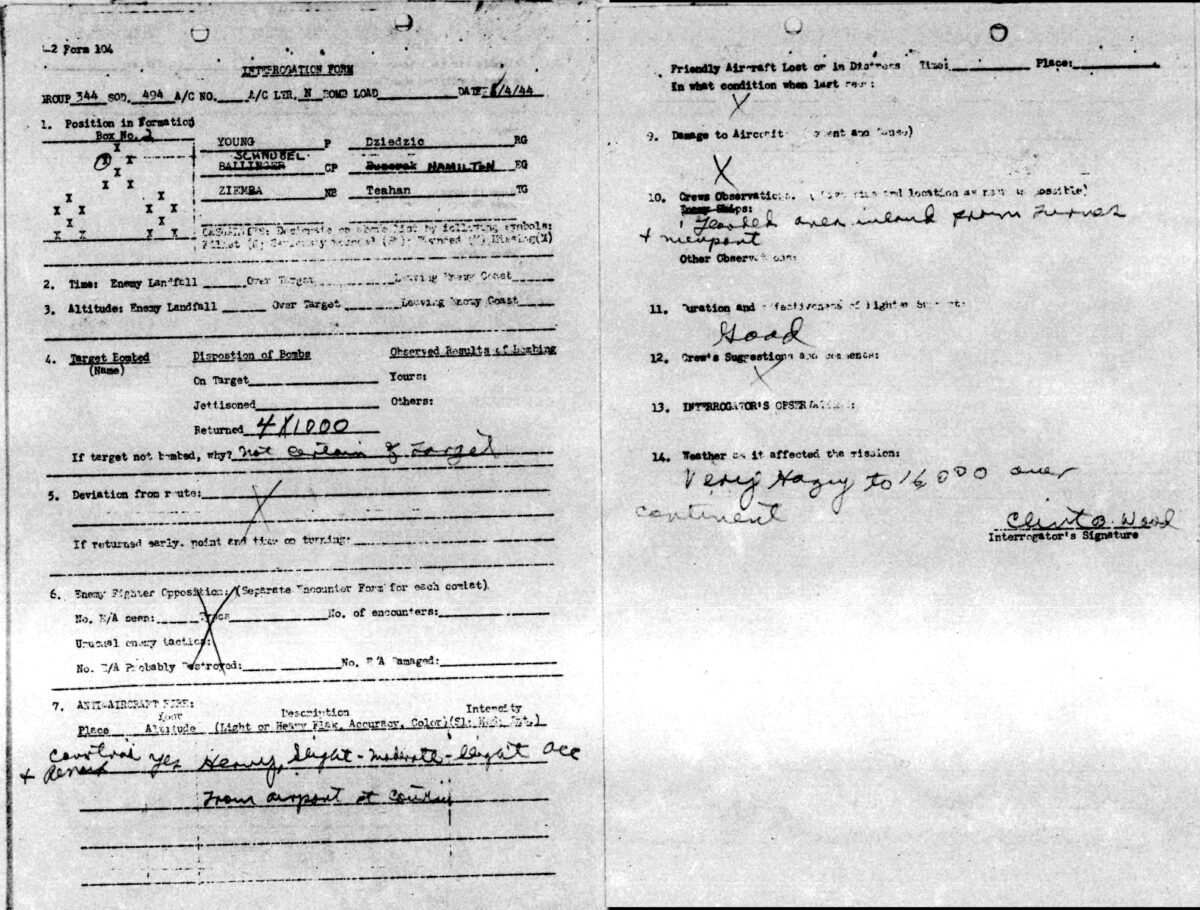
The crew included;Young – pilot, Schubel – co-pilot, Ziemba – navigator/bombardier, Dziedzic – radio/gunner, Hamilton – engineer/gunner, Teahan – tail gunner.
They carried 4 – 1000lb bombs that were returned to base when they were uncertain of the target. The flak they experienced varied from light to heavy and was accurate. The skies were hazy up to 16,000 ft over the continent.
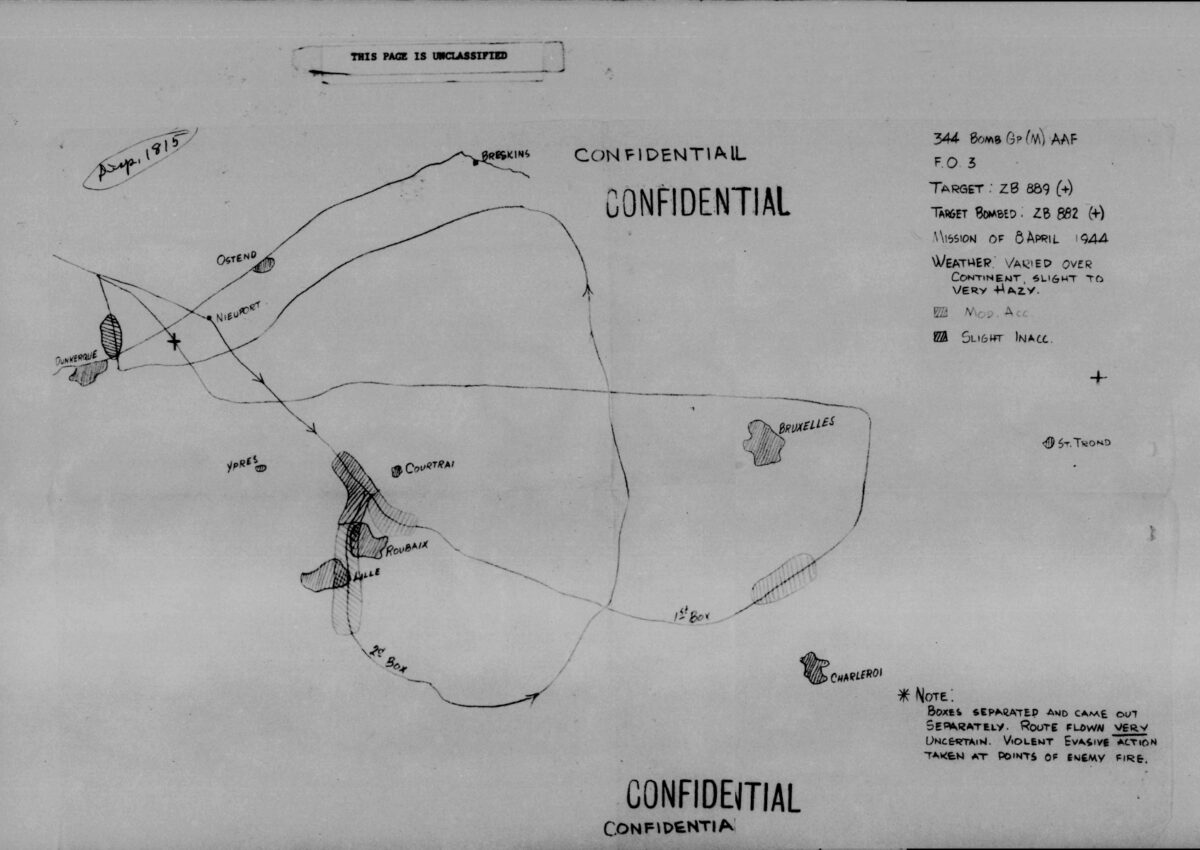
The map inset states that the boxes separated due to violent evasive action.
——————–
Lt. Young flew two missions on April 10, 1944.
According to 344th Silver Streaks– “Our next participation in Air Force plans was April 10, 1944. two missions were flown that day. The first was to attack a coastal gun battery at Le Harve/Le Clos on the French coast. Of the forty planes dispatched, thirty-nine harmlessly dropped 155 X 1000-pound
bombs in a field near the town of Marfanville some two miles distant from the gun position.
The first target was a gun battery near Le Havre/Le Clos on the French coast.
Their is no formation diagram for this mission.
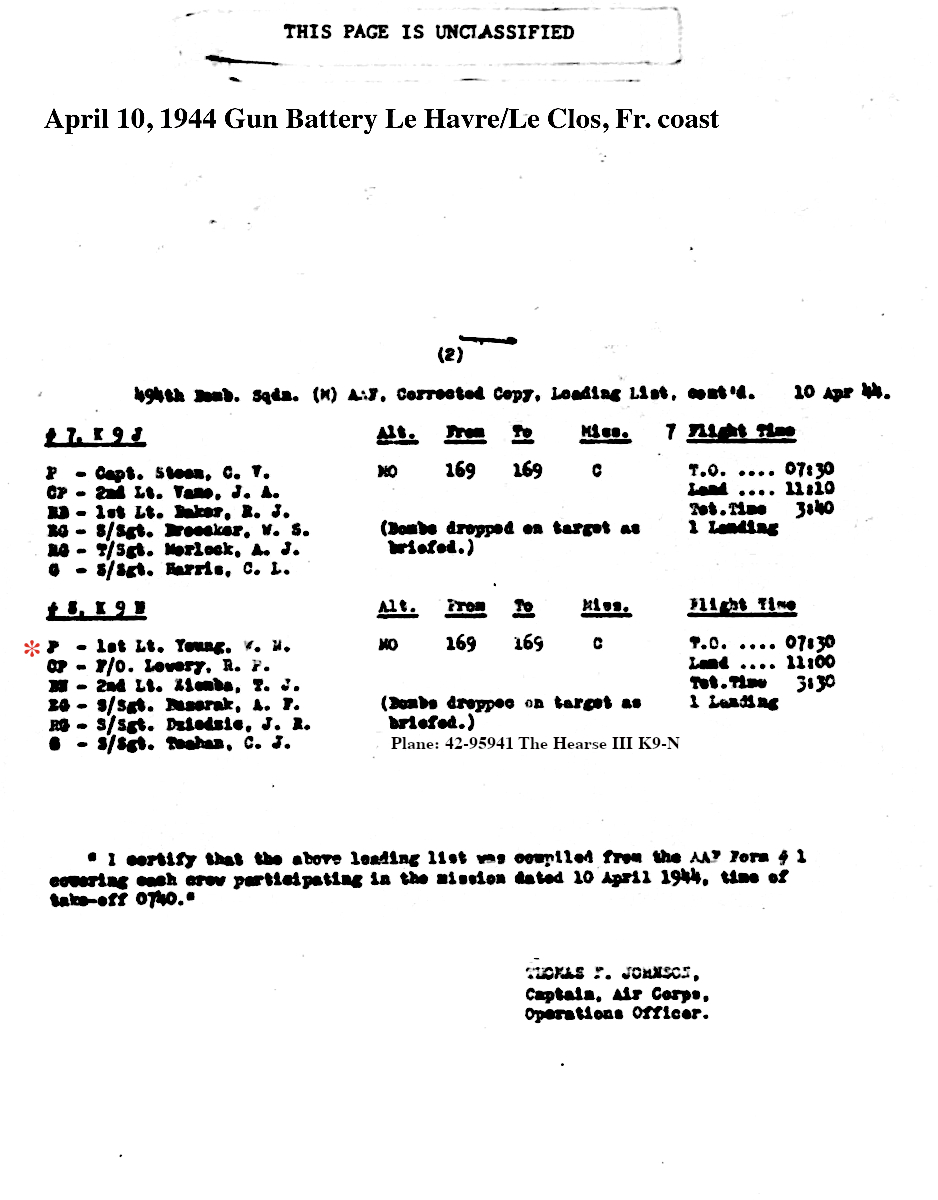
Their bombs were dropped on target.
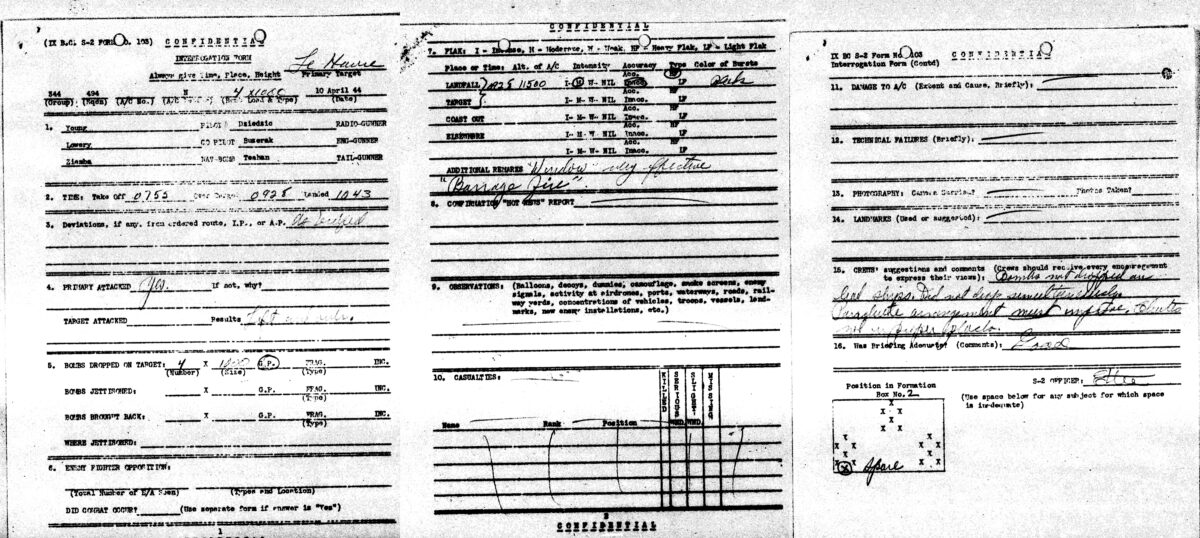
The debrief lists the crew as; Young – pilot, Lowery – co-pilot, Ziemba – navigator/bombardier, Dziedzic – radio/gunner, Buzerak – engineer/gunner, Teahan – tail gunner.
They flew in formation position 2-3-7 as a “spare.”
At 9:28 they dropped four 1000lb bombs on the target as briefed. Inaccurate flak was experienced upon landfall and at the target. Lt. Young deemed the “Window” (dropped tinsel radio jamming material) to be very effective as he described the flak as “barrage fire.”
Young was concerned that the formation did not drop their bombs simultaneously. He stated that their parachute arrangement must improve as the “chutes were not in their proper places.”
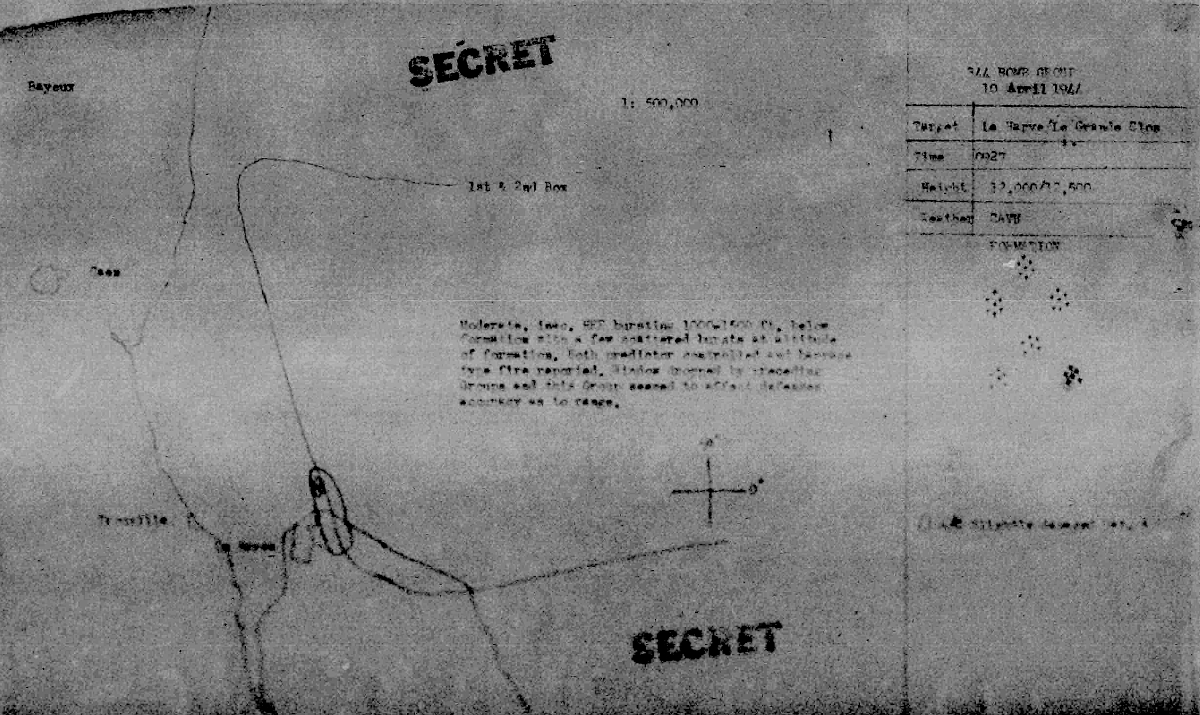
The second target on April 10, 1944 was to a Marshaling Yard in Namur, Belgium.
According to 344th Silver Streaks– “On the second mission of the day, the marshalling yard at Namur, Belgium, the group vindicated its earlier morning attack somewhat by dropping 152 X 1000- pound bombs from thirty-eight aircraft, on and near the tracks and goods wagons with good results. Some bombs went over the AP, making direct hits on paved roads south of the river and across from the railway yards.”
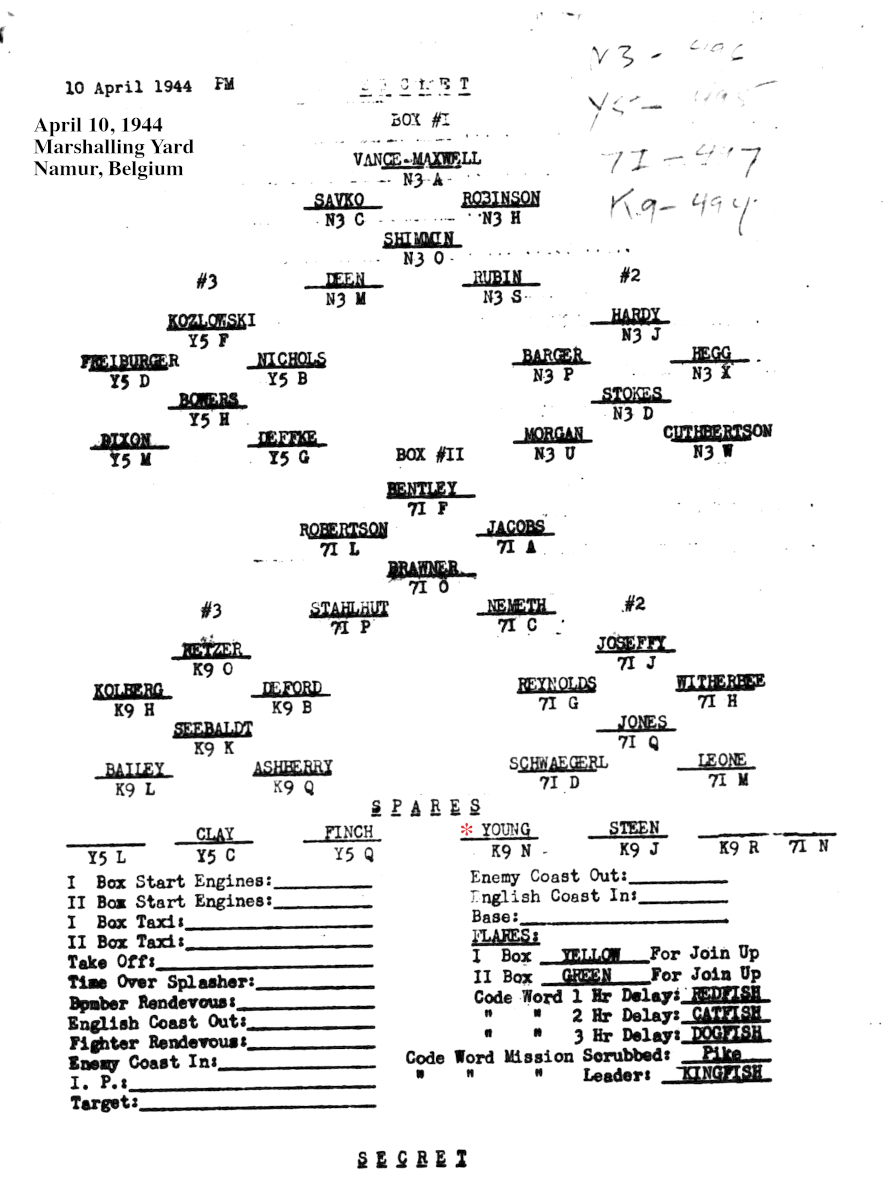
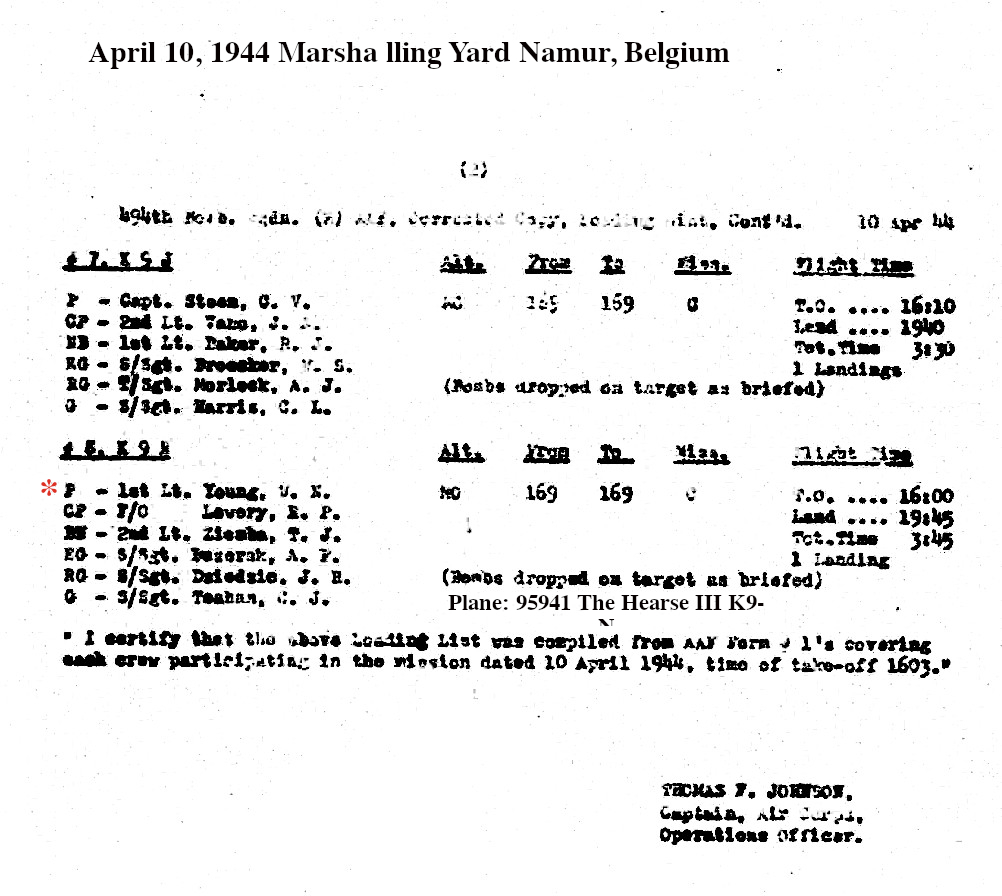
The crew included;Young – pilot, Lewery – co-pilot, Ziemba – navigator/bombardier, Dziedzic – radio/gunner, Imzerak? – engineer/gunner, Teahan – tail gunner.
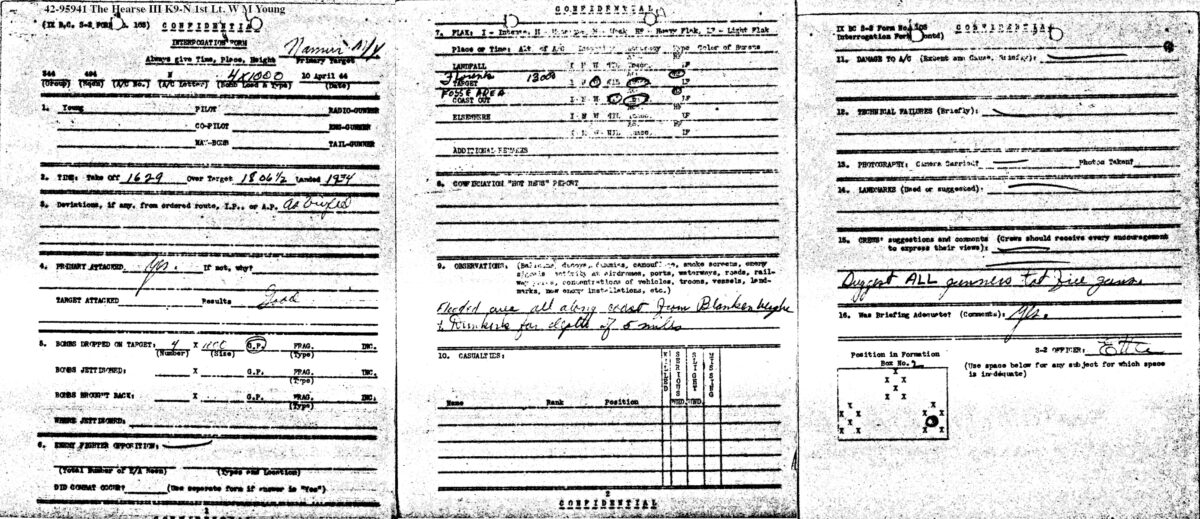
On this debrief, the crew was not listed. Lt. Young took off at 4:29 pm, was over target at 6:06pm and landed at the base at 7:34 pm. The plane assumed the 2-2-4 position in the formation. They dropped four 1000lb bombs with good results. They experienced weak and inaccurate flak over the target. Young cited flooding “all along the coast.” Young suggests that all gunners test their guns.
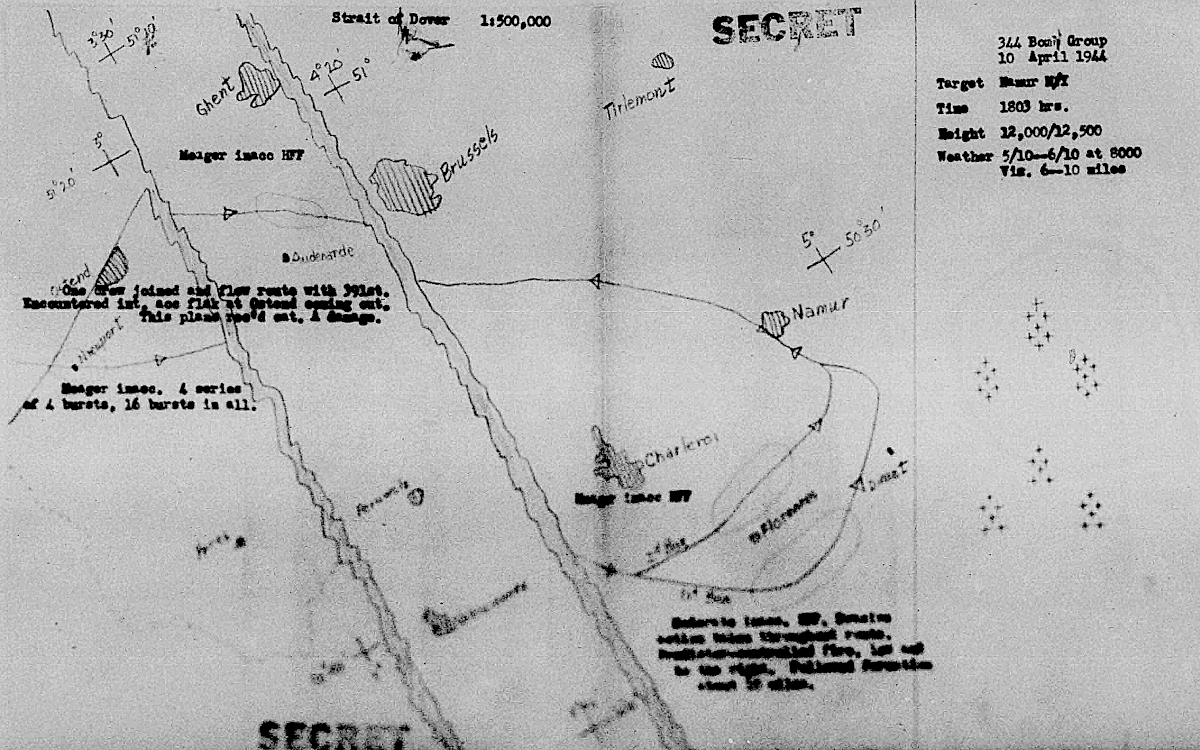
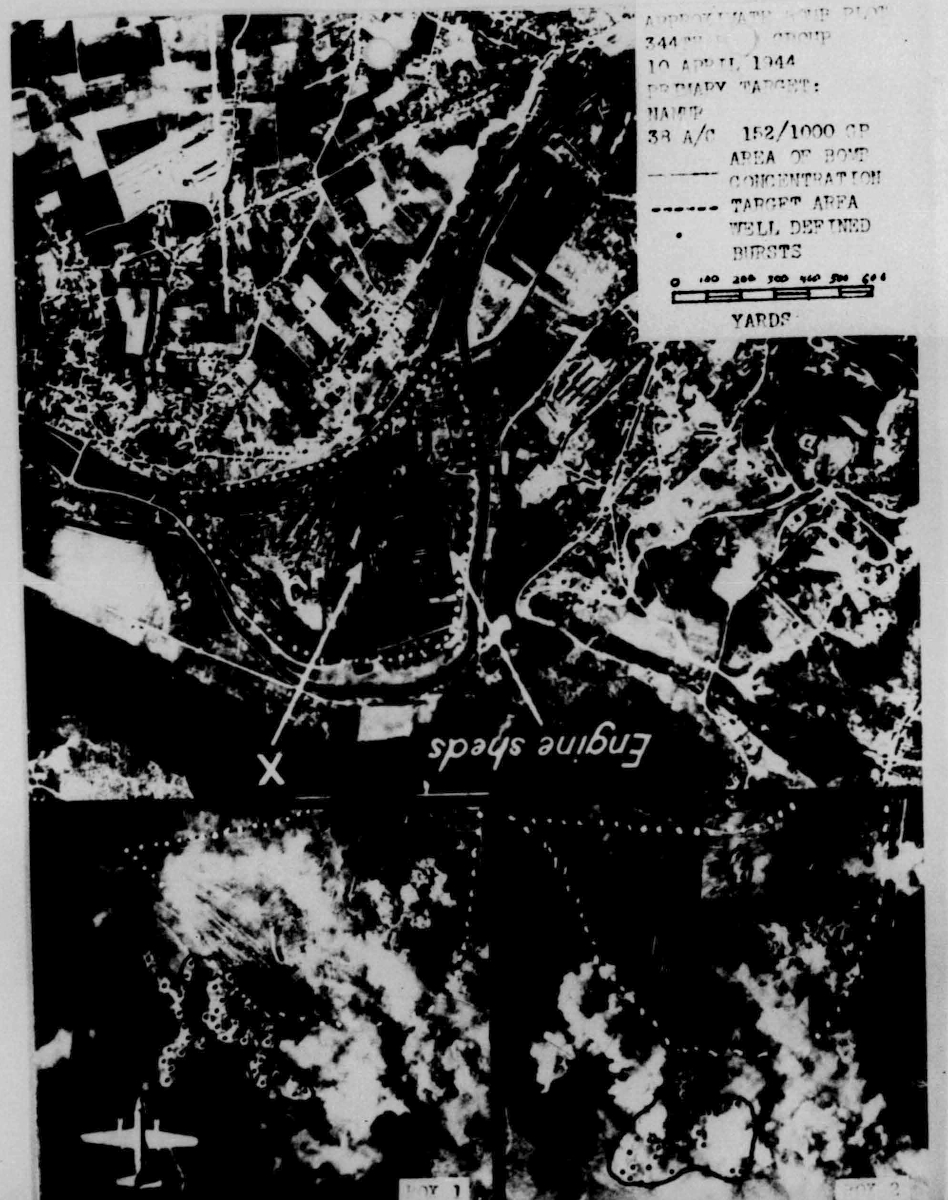
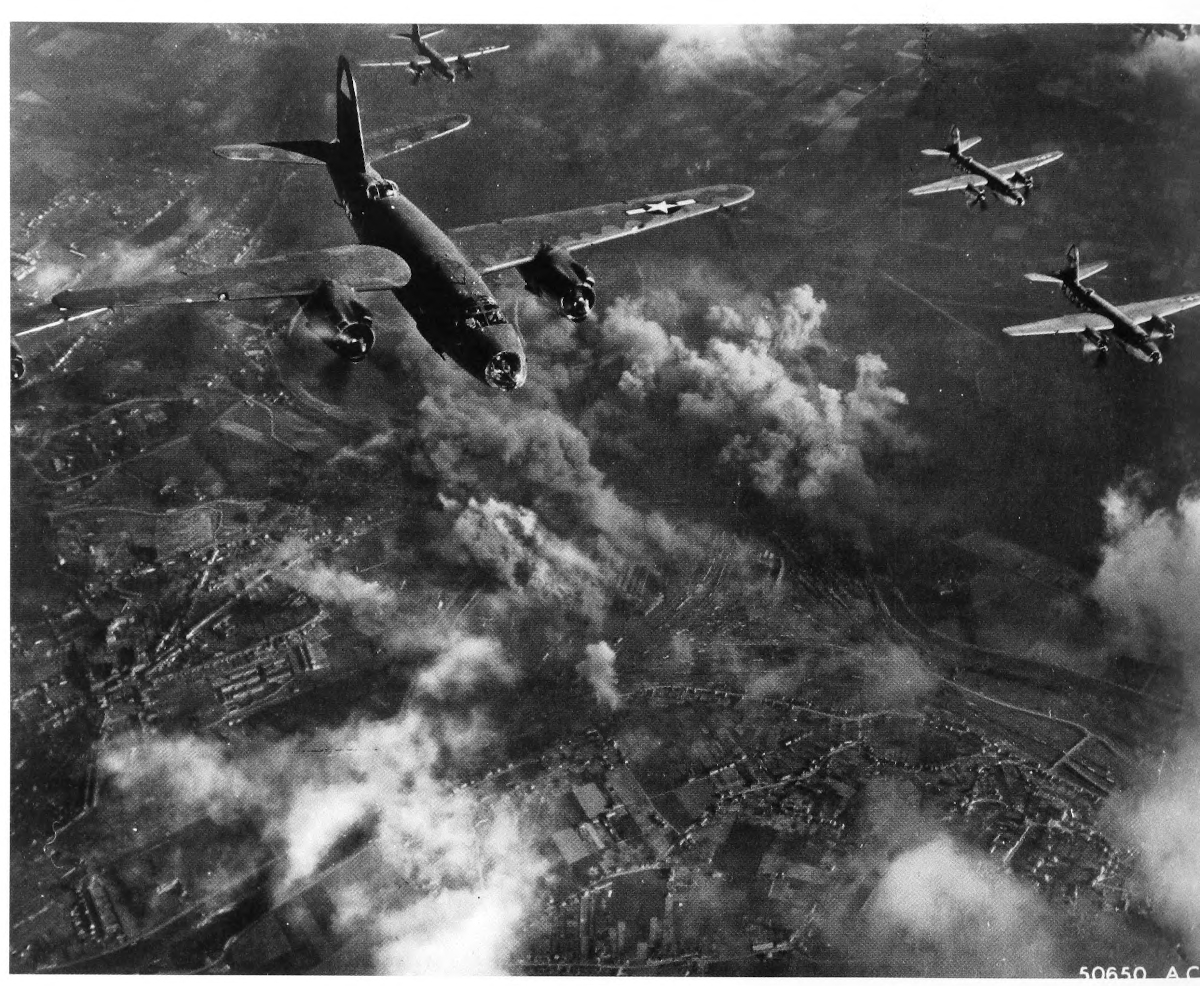
the hundred and fifty-odd B-26Marauder medium bombers of
the 9th Air Force which on April 10th seriously damaged the
railway marshaling yards at Namur, 35 miles southwest of
Brussels. The smoke rising from direct hits on the tracks and
freight cars show the kind of precision bombing the Marauders
have demonstrated in their heavy attacks against the German
transportation in Occupied Europe. Planes in this picture are
some of the unpainted system Marauders of a Marauder Group.
The natural aluminum finish, without paint, increases the speed
of the Marauder. (U.S. Air Force Photo courtesy Paul Benedict)
On April 11, 1944 the 344th bomb group targeted a marshaling yard at Montignies Sur Sambre, Belgium. No formation diagram is available.
According to 344th Silver Streaks– “The marshalling yard at Montignies-Sur-Sambre heard the roar of the “Silver Streaks” formation above it and felt the weight of its 532 X 250-pound General Purpose bombs on April 11, 1944. Photographic evidence of the results were obscured to a great extent by cloud coverage, but did show hits on a building on the south edge of the yards and near-hits on the engine shed.”
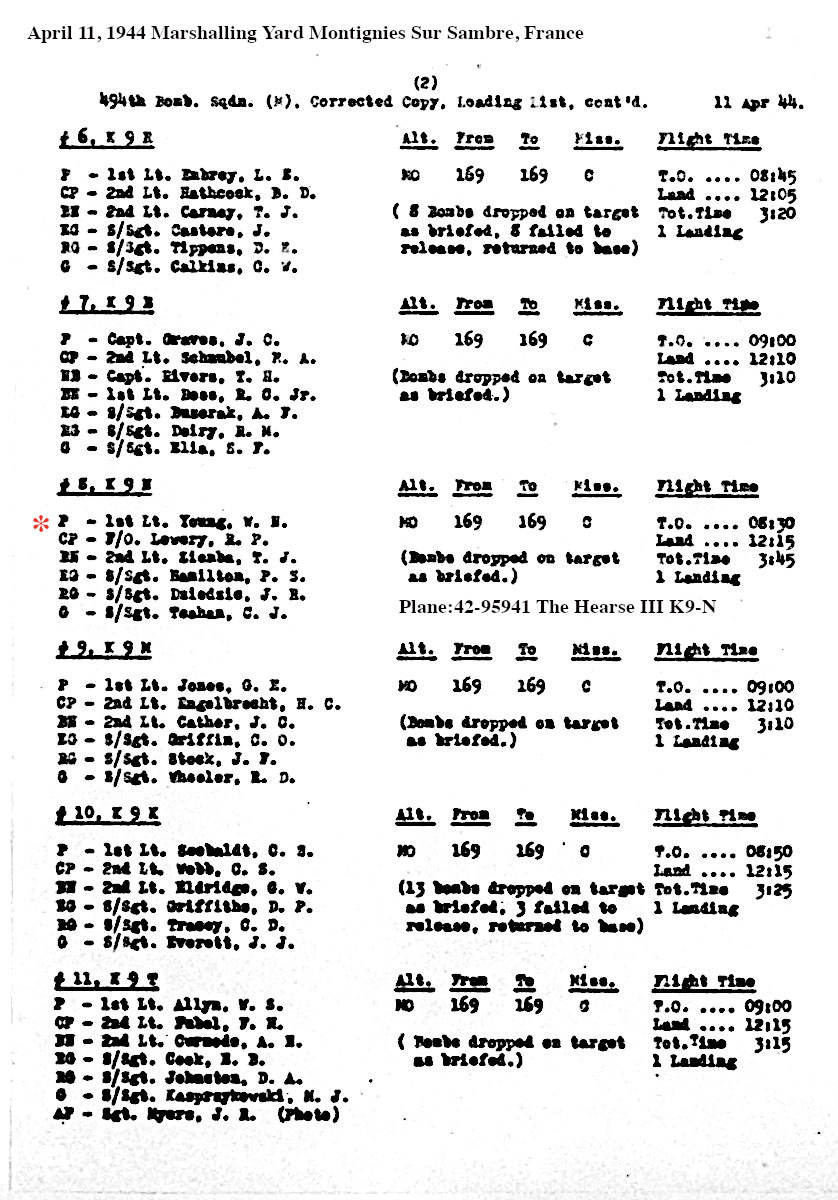
The crew included;Young – pilot, Lewery – co-pilot, Ziemba – navigator/bombardier, Dziedzic – radio/gunner, Hamilton – engineer/gunner, Teahan – tail gunner.
Take off was at 8:30 am and the landing at 12:15 pm. Their bombs were dropped on target. They flew in 42-95941 The Hearse III K9-N.
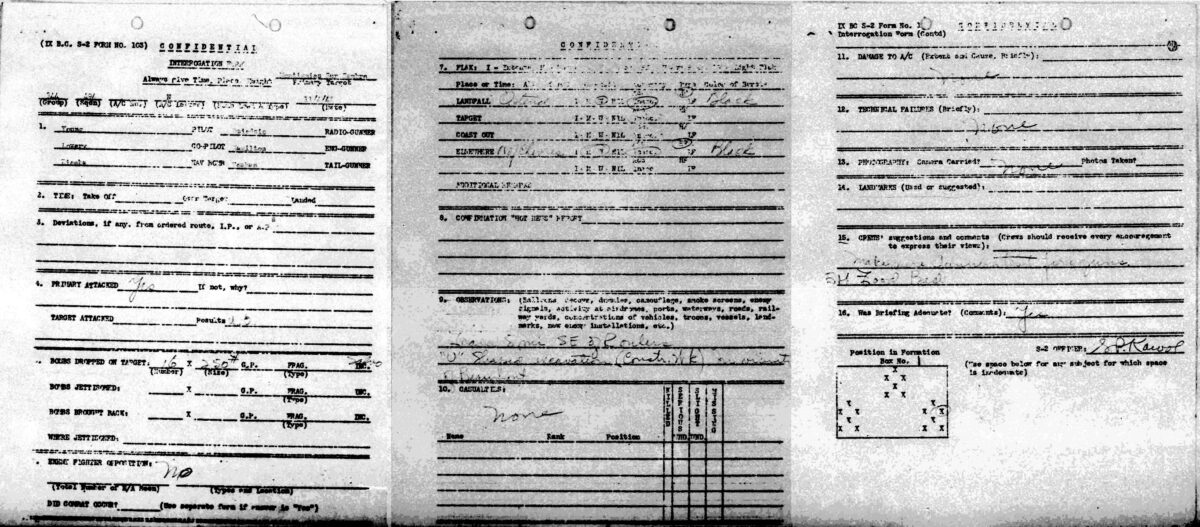
According to the debrief report, Young reports dropping 16 x 250lb incendiary bombs. No fighter opposition was experienced. Weak and inaccurate flak was observed. They flew in formation position 1-2-2.
________________
Teahan flew the second of two missions on May 9, 1944
____________________
Second mission of May 9, 1944.
According to 344th Silver Streaks– “On May 9, Maquise coastal defenses, 38 planes dispatched by 6 planes, only dropping bombs, the others being unable to pick up and identify the target due to weather conditions that prevailed.”
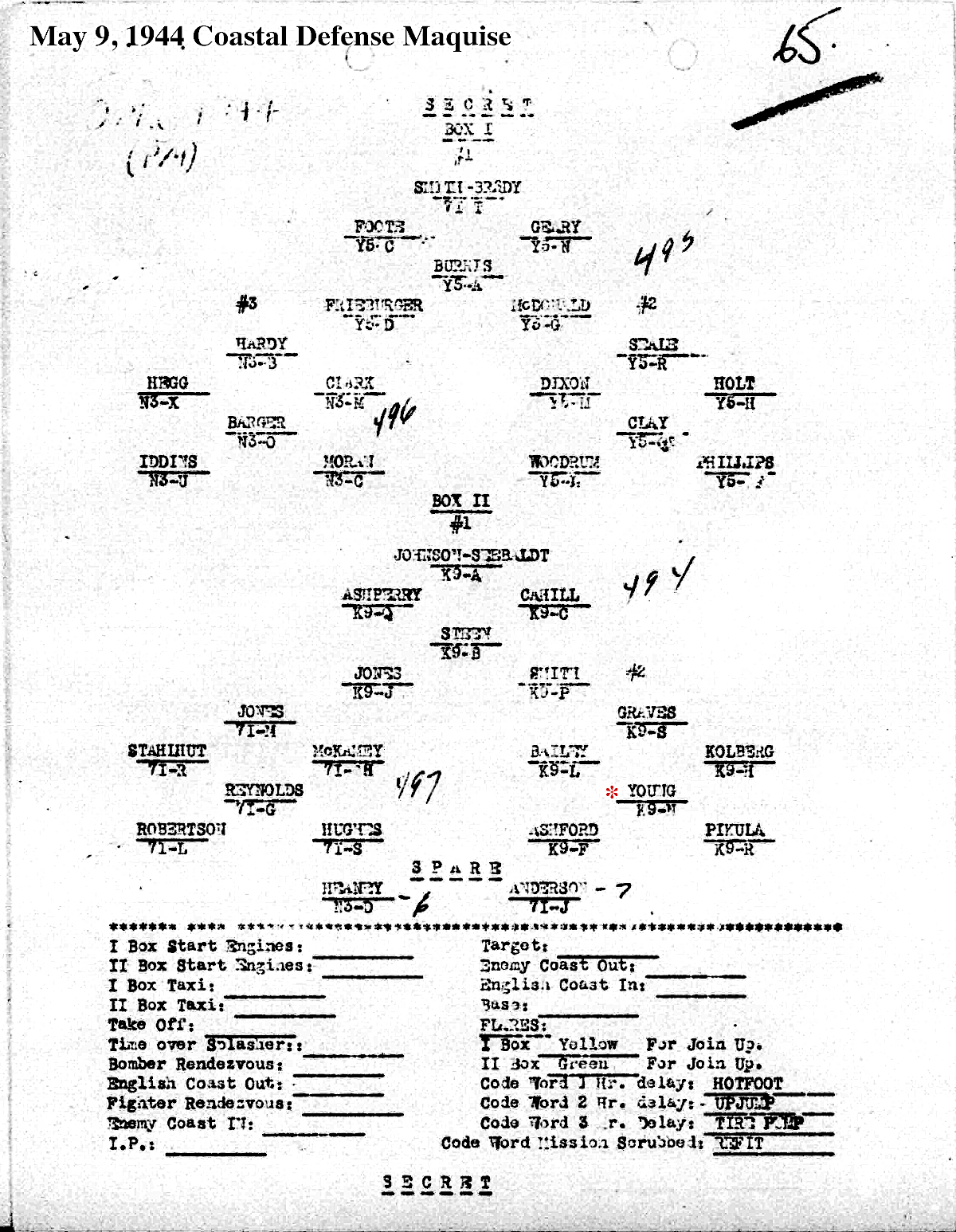
On the May 9, 1944 mission to attack coastal defenses near Maquise, France, Teahan and Young’s plane flew in formation position 2-2-4.
The target was chosen to help deceive the Germans into thinking the invasion would be near Calais rather than Cherbourg.
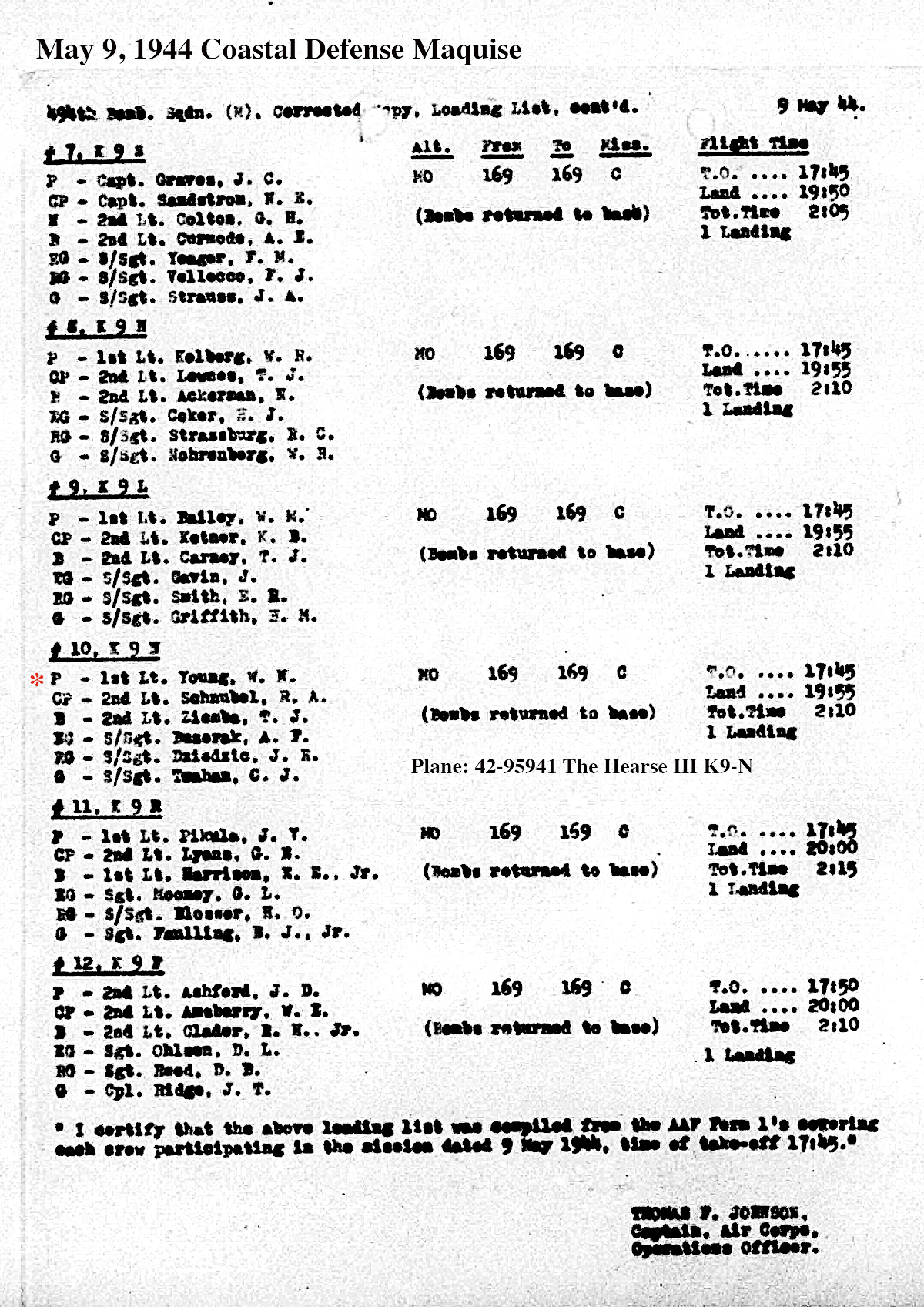
The crew included; Young – pilot, Schnubel – co-pilot, Ziemba – navigator/bombardier, Dziedzic – radio/gunner, Bazerak – engineer/gunner, Teahan – tail gunner.
Take off was at 5:45 pm and the landing at 7:55 pm. Their bombs were returned to base. They flew in 42-95941 The Hearse III K9-N.
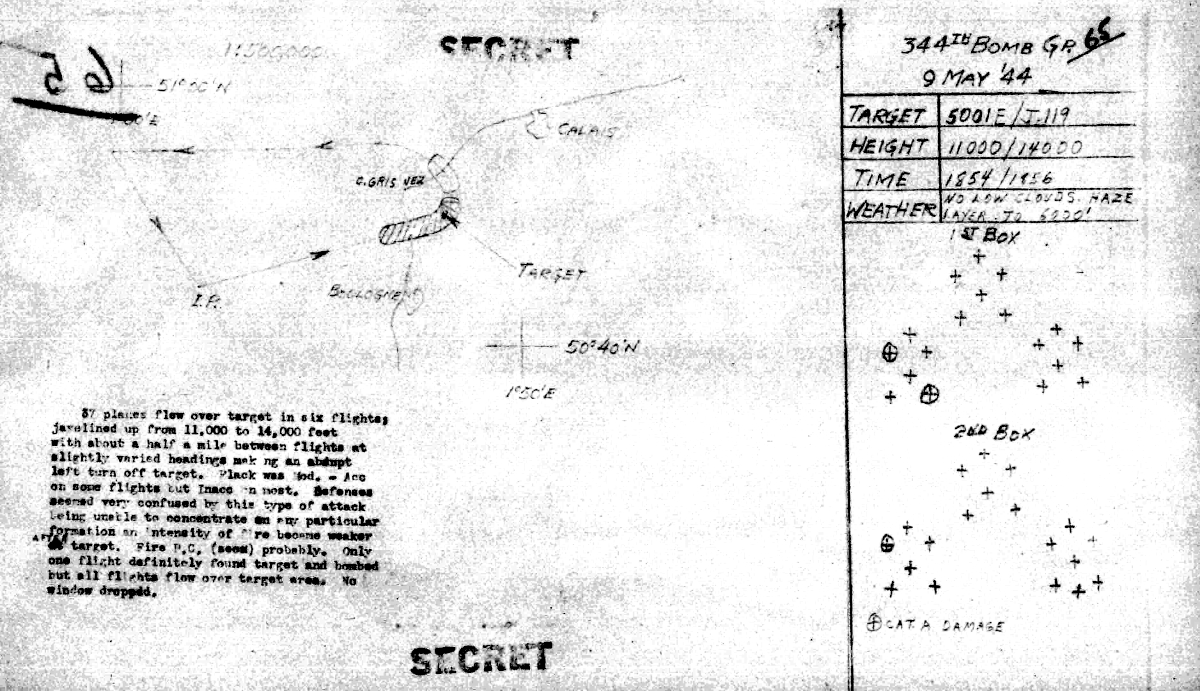
“37 planes flew over the target in six flights lined up from 11,000 to 14,000 feet with about a half a mile between flights at slightly varied headings making an abrupt left turn off target. Flack was Mod – Acc on some flights but inaccurate on most. Defenses seemed very confused by this type of attack being unable to concentrate on any particular formation an intensity of fire became weaker after target. Fire P.C. (seen) probably. Only one flight definitely found target and bombed but all flights flew over target area. No window dropped.”
Bombing commenced at 6:54 pm from 11,000 – 14,000 ft. There were no low clouds but there was a haze layer to 6000 ft. Three planes suffered category A damage.
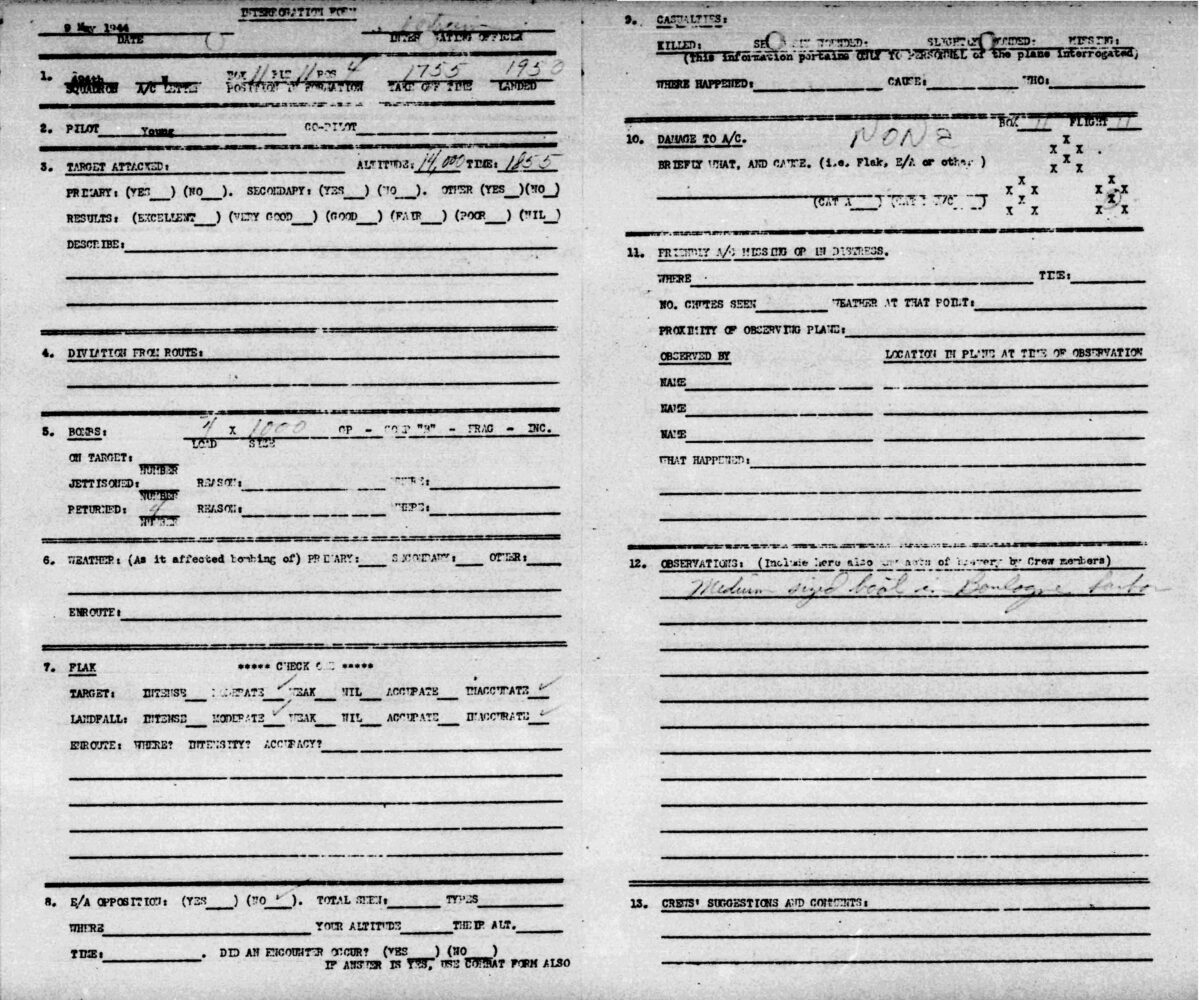
He took off at 5:55 carrying four 1000 lb bombs that were returned to base. He experienced moderate but inaccurate flak at the target and at landfall. Young and crew saw no enemy aircraft. There were no crew injuries or damage to the aircraft. They saw a medium sized boat in the Bologne Harbor.
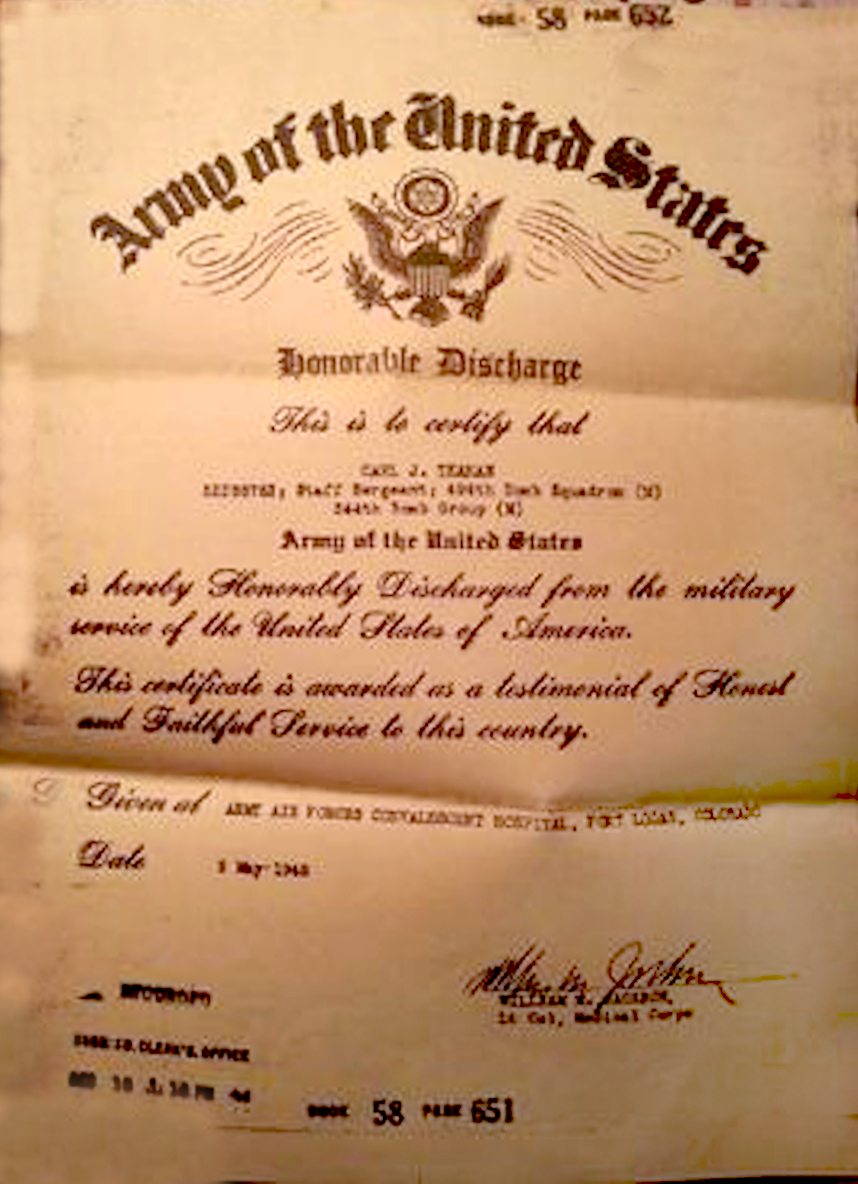
(*This article was printed in the Auburn Citizen newspaper in 2015.):
Sean J. VanHoltz
Lt Col/USAF
Editors’ note: Today we are printing the following submission — by a modern-day war veteran about a World War II veteran — in conjunction with the 70th anniversary of Victory in Europe Day on May 8, 1945:
On 30 April 2015, I flew back to my hometown, just outside Syracuse, to attend the calling hours of a man I consider a true American Hero. Mr. Carl J. Teahan Sr., formerly Staff Sgt. Teahan of the 494th Bomb Squadron, 344th Bomb Group had passed peacefully at the VA hospital in Syracuse on 26 April 2015 at age 96.
As a child I remember growing up in Skaneateles Falls around Carl, as he and his wife, Rosemary, were my parents’ closest friends. They did almost everything together: vacations, weekly cookouts, attend church, play cards, spend holidays, and his daughter Sue is my godmother. Though indirectly, and perhaps without even knowing, Carl had a part in raising me through my childhood years. I remember hearing from my mother that Carl was a tail-gunner in an old World War II bomber.
After many years, I remembered this tidbit from my childhood, and I decided to do some research in order to be certain that Staff Sgt. Carl J. Teahan had received all of the awards and decorations due him. I discovered that Carl was a Dorsal-Gunner on a B-26 Marauder in the 494th Bomb Squadron, 344th Bomb Group. He flew 59 combat missions over enemy-occupied Europe and was the recipient of the Distinguished Flying Cross, Air Medal with 9 oak leaf clusters, two Bronze Battle Stars, European Theater Medal, Overseas Service Bar and the Good Conduct Medal. As I read this list of awards and decorations on his discharge papers, I was simply amazed. It puts my ribbon cluster to shame.
Carl never mentioned his service and sacrifice during the time I knew him. I never really knew if it was a painful experience, too painful to discuss, or if he simply thought it was not a relevant conversation for this day and age. Well, I am certain that it is a relevant conversation, especially today as Memorial Day draws near.
When I saw that Carl had flown 59 combat missions, I was speechless. Then as I read further on his discharge papers, I realized his combat flights took place between the period 2 September 1943 to 10 May 1944. Only one in four bomber crews were expected to survive those 25 missions, and the odds against returning alive from subsequent missions were staggering. During the initial stages of World War II, flyers were projected (by their respective numbered Air Corps) to fly 25 missions (later 35, then 50 as enemy air power decreased by 1945), at which point they could return home on convalescent leave before returning to the fight. As I did more research I discovered that flying beyond the projected 25 missions early on in the war was commonplace among these World War II veterans, giving testament to the courage, valor, determination and willingness to sacrifice their own lives so that others may live free.
At the calling hours, Carl’s son, Carl Jr., told me that his dad jokingly told him one day that he didn’t know if he survived because he was such a good shot, or if the enemy was such a bad shot! I chuckled, remembering Carl Sr.’s positive personality so common to the members of his generation.
As I departed the calling hours to catch a flight back to North Carolina, I considered what my life would be like today if men like Carl had not stepped up to the plate to engage in combat, voluntarily by the thousands during World War II, to thwart tyrannous enemies across the world, and defend the freedom and liberty that we so casually and almost thoughtlessly enjoy today. I am quite certain that I never would have existed. You see, my father contracted polio at age 3, and he utilized crutches to walk until he took his own life at age 74. I never did really notice the crutches … it was just the way my dad got around. I remember my father telling me that he tried to enlist during World War II, several times, at various locations, but he was turned down each time due to having polio. His older brothers did serve, one an ambulance driver in France, and the other a combat infantryman throughout Europe, both carrying the scars of combat throughout their lives. I am certain that had Adolf Hitler’s Germany been victorious during World War II, my father would have been exterminated due to his so-called handicap … and I would never have existed. So it should go without saying — though I am making a point of saying it — I quite literally owe my life to the men who fought against this horrible tyranny and oppression during World War II.
According to Veterans Administration statistics, World War II veterans are passing at a rate of 492 each day, and there are only approximately 800,000 such veterans remaining out of the 16 million who served. I fear that many of us have not taken the time to truly contemplate the quality of life we enjoy today due to the men and women who fought and sacrificed for our liberty during that time. This year, Memorial Day takes place on 25 May 2015. I believe we owe it to our World War II veterans to make a truly diligent effort to reach out and express our gratitude for their sacrifice. I do not mean to minimize the sacrifice of veterans of other wars and military conflicts (of which I am included), I merely intend to recognize this greatest generation today as I remember Staff Sgt. Carl J. Teahan, U.S. Army Air Corps, World War II veteran — and American Hero.
Sean J. Van Holtz
Colonel, US Air Force
